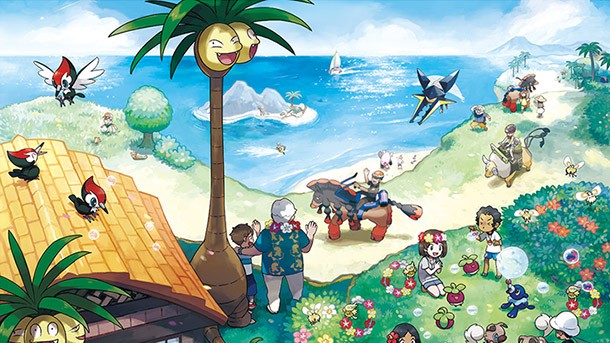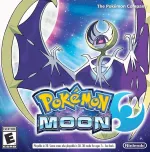Our extra-large special edition is here. Subscribe today and receive the 25% longer issue at no extra cost!
Pokémon Moon Review

Pokémon is a series that nailed its mechanics on the first try. It was a massive success and follow up entries have mostly stayed the course: Capture monsters, collect badges, and share your collection with friends. Sun & Moon is not a radical reinvention of Pokémon, but it does re-examine some ingrained mechanics and the result is a better, more diverse Pokémon experience that feels different from past games, even if it does have a familiar core.
The first thing I noticed is human character models and their animations have been dramatically improved. The Pokémon feel mostly unchanged, but the way your character and other NPCs move is significantly better. Grid movement is finally dead, and I couldn’t be happier. Animation improvements even help in storytelling. The narrative delivers familiar messages of kinship and working with your Pokémon friends, but it does hide a few surprises, as well as mysteries extending beyond the credits that are worth exploring.
Walking around in Alola feels better, and its layout is much friendlier. Tall grass is still unavoidable in some instances, but you can often take a path around it if you need to avoid combat. Alola’s islands are more open, and while it is in your best interest to explore the grass, fight, and collect, I was happy to discover the safe routes when I was just trying to go from point A to B. Even the trainers who can’t help but stop you in the road to battle offer more signs they’re prepared to pounce. You won’t make much progress if you avoid them all, but I like having a way out.
Mechanically, fighting is mostly unchanged. Z-Moves are the big twist this time around, replacing the Mega Evolutions of recent entries. Z-Moves act like a guaranteed critical hit, and each is accompanied by a dance. Maybe performing a dance to pull off an ultra move sounds dumb, but the excellent animation makes the dances fun to watch. The Pokémon-specific Z-Moves are also entertaining, as it gets your pocket monster involved in the often-absurd display. They function as a give-it-all-you-got attack to finish off a powerful foe, give yourself a strong lead, or to get you out of a tough situation. Using one is always an important decision and it’s a fun tactical play to use it against the right enemy at the right time in a difficult fight.

The rock-paper-scissors nature of fighting is still here, but now it remembers what attacks work best against which enemies for you. I’ve always struggled remembering the breakdown of strengths and weaknesses when it comes to Pokémon types, especially as new ones have been added over the years, so this reminder was invaluable to me. In the past, I would keep a document nearby listing all of the types’ strengths and weaknesses, and I am happy to leave it behind. Anything that keeps me playing the game and not putting it down to do research is a good thing.
Battling and collecting Pokémon feels the same, but finding Gym Badges is different. You complete Trials instead of taking on Gyms, and that’s more than just a change in terminology. Combat is still crucial to completing each Trial, but additional tasks make them all unpredictable. One has you listening to sound cues and identifying what they represent, while another tasks you with collecting ingredients to summon a powerful Totem Pokémon. I didn’t know what to expect going into each of these trials, and as a player who has collected his fair share of Gym Badges throughout his life, I enjoyed not knowing what was next. The non-combat parts of these Trials are never hard and usually played for laughs. The nature of the Trials also gives what would have been forgettable gym leaders in the past an opportunity to show some character and be more memorable. The Trial structure made me eager to go after each one, especially since they all award new Z-Moves (instead of just an icon attached to your save file).
HMs (hidden machines), which allow you to do things like learn to fly for fast travel, or break rocks for expanded exploration, are gone for Sun & Moon. Instead, you have a device that lets you call in Pokémon you can mount. You can ride Taurus, for example, to travel faster and break through rocks. I prefer this over the HM system, since it means you no longer have to sacrifice one of your Pokémon’s attack slots in order to perform special environmental moves. Plus, seeing your trainer ride around on assorted Pokémon as you control them is fun, and sometimes very dumb.
Your Pokédex offers more visual reward for collecting Pokémon, though the act of catching the creatures is unchanged. You can tell immediately if a Pokémon has an evolution when you catch it, and when you collect a full set, the background color of that Pokémon’s entry changes. It’s a small flair, but it makes filling out your Pokédex enticing, and it is easier to see what entries are missing.

Much of the clutter from the previous games has been removed for a U.I. with fewer distractions and mini-games. Pokémon-Amie has been renamed to Pokémon Refresh and while it continues to serve the same ignorable functions of the previous games like petting and feeding your team, it now also allows you to remove status ailments between fights. You can still go the standard route of using items to cure things like poison and paralysis, but I like having a “free” option that gives you a close-up look at the Pokémon models.
Poké Pelago can be accessed any time, and lets you periodically do something with the Pokémon living in your PC. The rewards are small, but I like even the idea that my Pokémon are not just languishing away in my PC. Festival Plaza is a physical place where you and your friends can socialize, trade, and battle. It does a good job limiting the menu-heavy interaction typically associated with playing Pokémon with friends. Sun & Moon’s Photo Mode is fairly shallow and is not the return of Pokémon Snap some hoped it would be. As an additional distraction to explore in Alola, however, it’s a welcome bonus. Strangely, it also represents the only element of the game in stereoscopic 3D. I did not miss stereoscopic 3D in the rest of the game, but I admit surprise at its near total absence.
Sun & Moon feels significantly different from previous Pokémon games. X & Y may have marked the series’ biggest visual change, but Sun & Moon shows Game Freak is willing to re-examine Pokémon’s tenured mechanics in order to improve the game. Sun & Moon is still Pokémon, but it showcases some of the biggest changes the series has ever seen – and that’s a good thing.





















Get the Game Informer Print Edition!
Explore your favorite games in premium print format, delivered to your door.
- 10 issues per year
- Only $4.80 per issue
- Full digital magazine archive access
- Since 1991










